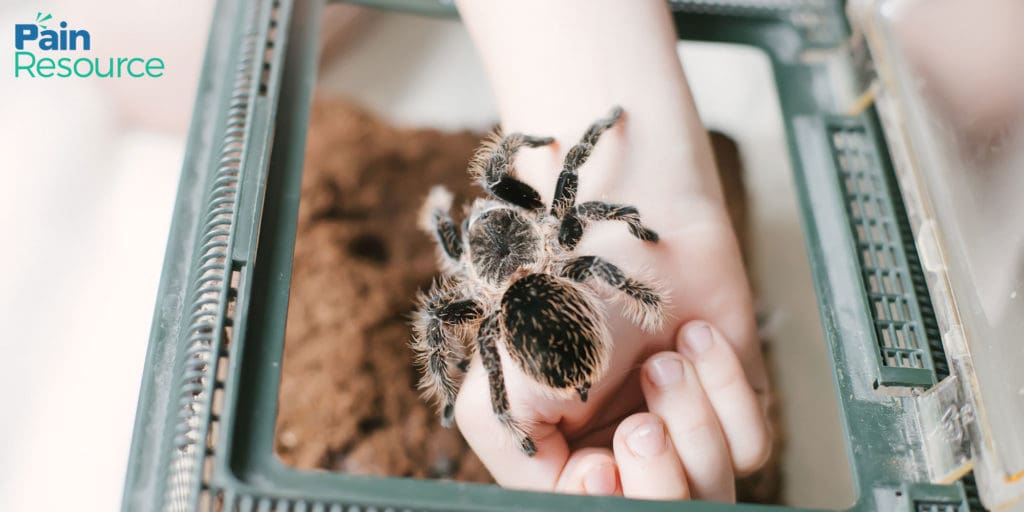A new study published in the journal Molecular Cell has made a promising discovery in spider venom that could lead to safer treatments for chronic pain in humans. Read on to learn what a tarantula, the Chinese bird spider, can teach us about pain and how we may eventually use this knowledge to treat it.
A Desperate Need and a Friend, Indeed
 Tarantulas are the stuff of nightmares for many people, particularly when they’re large enough to eat birds. But if you suffer from chronic pain, one day you may thank the Chinese bird spider.
Tarantulas are the stuff of nightmares for many people, particularly when they’re large enough to eat birds. But if you suffer from chronic pain, one day you may thank the Chinese bird spider.
In a recent study, researchers have discovered how this tarantula species with an 8-inch leg span paralyzes its prey. The insight may open the door to the development of a new class of pain medications.
There’s still a lot we don’t understand about the body’s response to pain, so it’s been challenging to develop safe pharmaceuticals to deal with it. The most effective medications currently available—opioids—create more problems than they solve in some cases. That means we desperately need a safer way to treat pain.
Who’d have thought that a solution may come from one of the creepiest creatures on earth? Several scientists, as a matter of fact—most recently from the University of Washington School of Medicine.
But before we get to that, let’s talk a little about pain and how pain meds work.
Understanding Pain
The perception of pain, called nociception, is a complicated process. It involves contact with an unpleasant stimulus, reception of a pain signal by nerves, transmission of the signal up through the spinal cord to the brain by those nerves, and finally, the brain’s reaction to the signal.
The two types of pain relievers—opioids and non-opioids such as NSAIDs and other over-the-counter medications—react to the signal at different points in the pain pathway. Non-opioids like aspirin or acetaminophen work by relieving acute pain at the injury site. The damaged cells produce an enzyme that releases prostaglandin, which provokes an inflammatory response to cushion the damaged tissue, followed by gradual healing. By stopping prostaglandin production, non-opioid pain relievers are able to stop some of the associated pains of an inflammatory response.
We know that with acute pain, neurotransmitters release endorphins, dynorphins, and enkephalins to provide relief. However, in the case of chronic pain, the body may not respond in the same way it reacts to acute pain. Often, we don’t even know the cause.
While non-opioid pain relievers eliminate acute pain by preventing the release of prostaglandin, opioids work differently. They target the perception of pain by blocking the transmission of pain signals by binding to opioid receptors in the spinal cord and brain.
And that’s where the study of venom comes in.
Why Spiders?


A 2018 study found that the venom of an ant spider, Lachesana tarabaevi, contains an antibacterial peptide that may be effective against methicillin-resistant Staph aureus (MRSA), a crucial development for humans as we deal with accelerating bacterial resistance to known antibiotics.
In 2017, Australian researchers discovered a compound in funnel-web spider venom that may prevent brain damage following a stroke.
Earlier this year, scientists found a compound in the venom of the Venezuelan Pinkfoot Goliath tarantula that may relieve pain from irritable bowel syndrome.
And several earlier studies of Chinese bird spider venom (called huwentoxin) have made valuable discoveries that ultimately led to the current findings of chronic-pain relieving potential in this species.
How It Works


The discovery involved the creation of an ingenious chimera, or hybrid of two species. In this case, the researchers combined a human sodium channel called Nav1.7 with a sodium channel from a bacterium. With a high-resolution cryo-electron microscope, the researchers could visualize the results when they introduced the spider venom to the hybrid model.
They observed that the venom acts as a stinger that targets sodium channels in the prey’s body. Sodium channels are responsible for generating electrical signals that operate muscles and nerves. The venom traps voltage sensors on the channels in their resting state so they are unable to activate and produce movement, and the victim is paralyzed.
The researchers hope to use this information as a model to create medications without addictive potential that can block sensory nerve signals with a similar mechanism.
It’s Early Days Yet
As exciting as these studies are, there’s a long road ahead to developing new pain medications. Although the researchers have successfully tested the technique on mice, they need to conduct more animal studies followed by controlled trials with human subjects.
Still, the current research opens doors to developing a safe and effective alternative to opioids. With the help of the creepiest of creatures, the nightmares of chronic pain sufferers may one day be over.
NEW UPDATE: David Copenhaver, M.D., M.P.H., routinely treats patients who suffer from chronic pain and sees significant unmet medical need for effective pain relief. “Sometimes chemotherapy-induced neuropathic pain is so problematic that a patient won’t continue chemo, which is a lifesaving treatment, because the pain is so severe,” David Copenhaver explains. Read the article at The National Institute of Health mentioned about Turning tarantula venom into a non-opioid treatment for pain on this article about Protein Engineering for Chronic Pain.
King Baboon Tarantula Venom Could Cure Chronic Pain
What new chronic pain treatments are you excited about?
We want to read all about it in the comments section below!





WOW just what I was searching for.